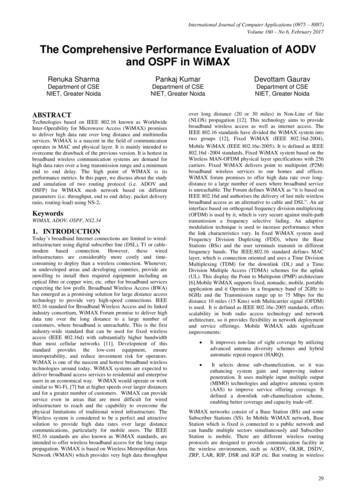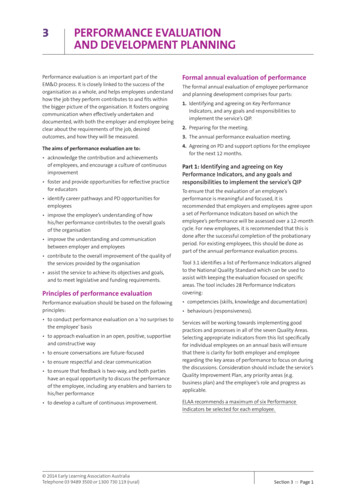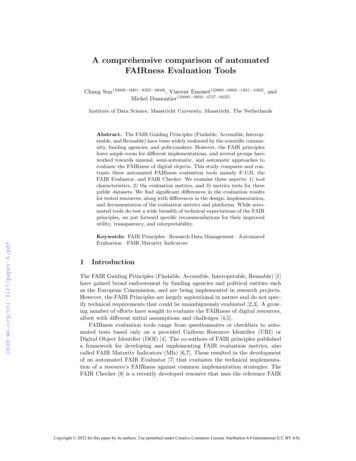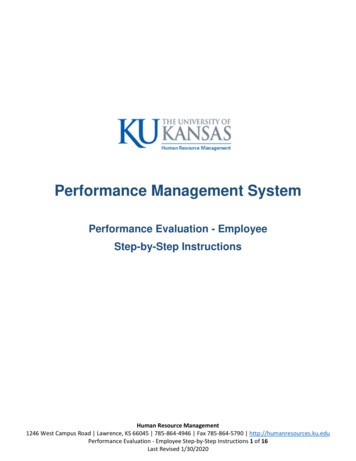
Transcription
International Journal of Computer Applications (0975 – 8887)Volume 160 – No 6, February 2017The Comprehensive Performance Evaluation of AODVand OSPF in WiMAXRenuka SharmaPankaj KumarDevottam GauravDepartment of CSENIET, Greater NoidaDepartment of CSENIET, Greater NoidaDepartment of CSENIET, Greater NoidaABSTRACTTechnologies based on IEEE 802.16 known as WorldwideInter-Operability for Microwave Access (WiMAX) promisesto deliver high data rate over long distance and multimediaservices. WiMAX is a nascent in the field of communicationoperates in MAC and physical layer. It is mainly intended toovercome the drawback of the previous version. It is hottest inbroadband wireless communication systems are demand forhigh data rates over a long transmission range and a minimumend to end delay. The high point of WIMAX is itsperformance metrics. In this paper, we discuss about the studyand simulation of two routing protocol (i.e. ADOV andOSFP) for WIMAX mesh network based on differentparameters (i.e. throughput, end to end delay, packet deliveryratio, routing-load) using NS-2.KeywordsWIMAX, ADOV, OSPF, NS2.341. INTRODUCTIONToday’s broadband Internet connections are limited to wiredinfrastructure using digital subscriber line (DSL), T1 or cablemodem based connection. However, these wiredinfrastructures are considerably more costly and timeconsuming to deploy than a wireless connection. Whenever,in undeveloped areas and developing countries, provide areunwilling to install then required equipment including anoptical fibre or copper wire, etc. other for broadband servicesexpecting the low profit. Broadband Wireless Access (BWA)has emerged as a promising solution for large distance accesstechnology to provide very high-speed connections. IEEE802.16 standard for Broadband Wireless Access and its linkedindustry consortium, WiMAX Forum promise to deliver highdata rate over the long distance to a large number ofcustomers, where broadband is unreachable. This is the firstindustry-wide standard that can be used for fixed wirelessaccess (IEEE 802.16d) with substantially higher bandwidththan most cellular networks [11]. Development of thisstandard provides the low-cost equipment, ensureinteroperability, and reduce investment risk for operators.WiMAX is one of the nascent and hottest broadband wirelesstechnologies around today. WiMAX systems are expected todeliver broadband access services to residential and enterpriseusers in an economical way. WiMAX would operate or worksimilar to Wi-Fi, [7] but at higher speeds over larger distancesand for a greater number of customers. WiMAX can provideservice even in areas that are most difficult for wiredinfrastructure to reach and the capability to overcome thephysical limitations of traditional wired infrastructure. TheWireless system is considered to be a perfect and attractivesolution to provide high data rates over large distancecommunications, particularly for mobile users. The IEEE802.16 standards are also known as WiMAX standards, areintended to offer wireless broadband access for the long rangepropagation. WiMAX is based on Wireless Metropolitan AreaNetwork (WMAN) which provides very high data throughputover long distance (20 or 30 miles) in Non-Line of Site(NLOS) propagation [12]. This technology aims to providebroadband wireless access as well as internet access. TheIEEE 802.16 standards have divided the WiMAX system intotwo groups [12], Fixed WiMAX (IEEE 802.16d-2004),Mobile WiMAX (IEEE 802.16e-2005). It is defined as IEEE802.16d -2004 standards, Fixed WiMAX system based on theWireless MAN-OFDM physical layer specifications with 256carriers. Fixed WiMAX delivers point to multipoint (P2M)broadband wireless services to our homes and offices.WiMAX forum promises to offer high data rate over longdistance to a large number of users where broadband serviceis unreachable. The Forum defines WiMAX as “it is based onIEEE 802.16d and authorises the delivery of last mile wirelessbroadband access as an alternative to cable and DSL”. An airinterface based on orthogonal frequency division multiplexing(OFDM) is used by it, which is very secure against multi-pathtransmission a frequency selective fading. An adaptivemodulation technique is used to increase performance whenthe link characteristics vary. In fixed WiMAX system usedFrequency Division Duplexing (FDD), where the BaseStations (BSs) and the user terminals transmit in differentfrequency bands. The IEEE.802.16 standard defines MAClayer, which is connection oriented and uses a Time DivisionMultiplexing (TDM) for the downlink (DL) and a TimeDivision Multiple Access (TDMA) schemes for the uplink(UL). This display the Point to Multipoint (PMP) architecture[6].Mobile WiMAX supports fixed, nomadic, mobile, portableapplication and it Operates in a frequency band of 2GHz to6GHz and the Transmission range up to 75 Mbps for thedistance 10 miles (15 Kms) with Multicarrier signal (OFDM)is used. It is defined as IEEE 802.16e-2005 standards, offersscalability in both radio access technology and networkarchitecture, so it provides flexibility in network deploymentand service offerings. Mobile WiMAX adds significantimprovements: It improves non-line of sight coverage by utilizingadvanced antenna diversity schemes and hybridautomatic repeat request (HARQ). It selects dense sub-channelization, so it wasenhancing system gain and improving indoorpenetration. It uses multiple input multiple output(MIMO) technologies and adaptive antenna system(AAS) to improve service offering coverage. Itdefined a downlink sub-channelization scheme,enabling better coverage and capacity trade-off.WiMAX networks consist of a Base Station (BS) and someSubscriber Stations (SS). In Mobile WiMAX network, BaseStation which is fixed is connected to a public network andcan handle multiple sectors simultaneously and SubscriberStation is mobile. There are different wireless routingprotocols are designed to provide communication facility inthe wireless environment, such as AODV, OLSR, DSDV,ZRP, LAR, RIP, DSR and IGP etc. But routing in wireless29
International Journal of Computer Applications (0975 – 8887)Volume 160 – No 6, February 2017network is very challenges task due to high mobility andfrequently changes of nodes. This paper presented anperformance analysis of reactive routing Protocols (AODV)and proactive protocols (OSPF) in WIMAX environmentbased on different parameters (i.e. throughput, end to enddelay, packet delivery ratio, routing-load) using differentscenarios.2. RELATED WORKIn 2016, A.B Ali, et. al. [17], discussed in this an author findout the best protocol combination for any complex scenario toachieve fast and reliable communication. In this they used HotStandby Routing Protocol (HSRP) and Gateway LoadBalancing Protocol (GLBP) is also simulated to analyze theload balancing and redundancy parameter for Border GatewayProtocol (BGP). Based on the simulation results it can beobserved that EIGRP and OSPF are the best combination ofprotocols for a given network within1000 hosts. However, acombination EIGRP and RIPv2 would be better suited for asmaller network because of the absence of segmented areas.In this IS-IS has been also known as the best protocol forISP’s and really large enterprises because of its scalability,fast convergence and added the advantage of not needing IPconnectivity to be able to communicate with neighbors. Theresults also conclude that it communicates well with OSPF,due to their similarities. So the author discussed that, thecombination of the two protocols would be better thanconfiguring only 1 of them for any given scenario withcomplex parameters.In 2016, T. Sharma et. al. [19], discussed an analysis ofADOV, DSR and DSDV protocol for WiMAX mesh networkbased on average end to end delay, packet delivery ratio,throughput and normalized routing load has been done.Successfully results found that AODV protocol outperformthe DSR and DSDV.In 2015, P. Ashar [18], discussed in this author summarizesthe features of some of the most significant protocols likeRIP, OSPF, IS-IS, IGRP, EIGRP and BGP, while comparingtheir individual functioning.In 2015, F. Anwar et. al. [17], discussed this paper provide afocus upon those routing protocols especially designed forwireless networks. In which author compare the performanceof four wireless routing protocols (AODV, DSR, OLSR andZRP) for Mobile WiMAX environment under the assumptionthat each of the mobile station has routing capabilities withinits own network. From simulation, they found that ZRP andAODV protocols outperform DSR and OLSR.In 2014, G. Kaur et. al. [16], discussed an analysis of thoserouting protocols especially designed for wireless networks. Astudy and comparison on the performance of reactive protocol(AODV) and proactive protocols (OLSR, DSDV) for MobileWiMAX environment is done under varying mobilityconditions. The performance matrix includes Packet Deliveryfraction (PDF), Throughput, End to End Delay, and routingload were identified. In this author used NS2 simulator for thecompare the performance analysis. From the results theyfound that AODV protocol out-perform the DSR and DSDV.In 2012, K. Khandakar[15], discussed in this author doesComparison of DSR, AODV and DSDV based onperformance metrics Packet Delivery Fraction , End to enddelay and Normalized Routing load while changing thenumber of nodes, speed and Pause time. AODV has a stableEnd to End Delay despite mobility as it has the feature of OnDemand Routing protocol and also maintains a Routing table.DSDV has a higher Packet delivery fraction than the othertwo routing protocols in mobility as it is a Table Drivenprotocol and is more reliable.DSR has the highest End to EndDelay and Routing load increases the bandwidth andconsuming the battery life. Based on the simulation scenario,parameter, assumption, the results of AODV could beconsidered as an efficient faster routing protocol than DSRand DSDV but has a higher Routing load comparatively thanDSDV.In 2008, K. Etemad et. al. [14], discussed this paper providesa high-level overview of mobile WiMAX technology and itsevolution from both radio and network perspectives. Thetechnology utilizes advanced PHY and MAC techniques inradio to provide high band efficiency and quality of service(QoS) control as well as IP-based flat network architecturesupporting multivendor plug and play deployments. MobileWiMAX has defined the technology evolution roadmap forthe next few years, which includes, but goes beyond, furtherimprovements in system efficiency and user experience.3. WIRELESS ROUTING PROTOCOLS3.1 Mobile Ad Hoc Network (MANET)MANET itself stand for Mobile Ad Hoc Networks, in whicheach node act as router and it can move freely anywhere in thenetwork. In other words, Mobile Ad Hoc Networks is selforganizing network, in which each node communicates witheach other without relying on existing infrastructure andwirelessly [23].The feature of self-organizing and self –administration make it applicable for various applications,such as military operation, wireless mesh network andwireless sensor network etc. al. Mobile Ad Hoc Networks canallow multihop to the destination and support for mobilitywith various features (robustness, rapid deployment,flexibility, etc.). Mobile Ad Hoc Networks can be classifiedinto Table-Driven and On-Demand Routing protocol whereTable Driven protocols are proactive and maintain a routingtable or it is static in nature and On-Demand are active and donot maintain a routing table or dynamic in nature [15], and acombination of reactive and proactive are called hybridrouting.Reactive Protocols: it is also known as on-demand routingprotocols. These protocols initialize the routing processwhenever a node requires otherwise the network is going tosleep. These are considered efficient, where the routediscovery is required to be less frequent. This makes themmore suitable to the network with less traffic and low mobility[16]. Examples of reactive protocols are Ad-Hoc on DemandDistance Vector Routing Protocol (AODV), and DynamicSource Routing (DSR).Proactive Protocols: The table driven approach is similar tothe connectionless approach of forwarding data packets, withno regard to when and how frequently such routes are desired.It relies on an underlying routing table update mechanism thattables are updated regularly in order to maintain a up-to-daterouting information from each node to every other node. Here,a route to every other node in ad-hoc network is alwaysavailable, regardless of whether or not it is needed [23]. Theseprotocols are used where the route requests are frequent [16].Examples of such protocol are DSDV (Destination SequenceDistance Vector Routing Protocol), OSPF (Open ShortestPath First), etc.Hybrid Routing Protocols: These protocols combine theadvantages of the two routing protocols in order to gain higherefficiency. In these a network is portioned in to the zones, in30
International Journal of Computer Applications (0975 – 8887)Volume 160 – No 6, February 2017which if the routing is to be carried out within the zone thantable driven routing is used else on demand routing is used[23]. Example of such Protocol is Dynamic MANETs Ondemand Routing.Here we are discussing those routing protocols used in thesimulation process.3.2 Ad hoc On-demand Distance VectorRouting (AODV)AODV is a reactive routing protocol which is combination ofDSDV and DSR. Route is calculated on demand, just as it isin DSR via route discovery process [15]. Even though ADOVis reactive routing protocol still it maintain a table. ADOVoffers quick alteration to dynamic link condition, low memoryoverhead, low network consumption, low dispensation, andunicast route purpose to destination within the ad hocnetwork. In ADOV distance and path calculated on demandi.e. when the request is sent from the source node to asubsequent node. It uses a destination sequence number(DSN) to ensure loop free route all the times, avoiding trouble[19].The ADOV protocol divided into two major phases:[19] Route discovery Route maintenance3.2.1 Route discoveryWhen a node wants to send a packet to some destination nodeand does not find a valid route in its routing table, it initiates aroute discovery process. Source node broadcast a routerequest (RREQ) packet to its neighbors [17], an intermediatenode receives a RREQ broadcast massage it copies theaddress of a node from which it has received massage. It thenappends its RREP massage to the broadcast massage thiscreating a reverse path. This path is used to unicast themassage back to back to the destination [19].Figure 1: Propagation of route request throughout thenetwork3.2.2Route maintenanceA node is connected to the route path till an active connectionis needed .however, in certain circumstances if the sourcenode moves further away from its adjacent path node then itcan easily reinstate a connection back to the adjacent node andrestart communication. If an intermediate node disconnectsfor this purpose, the effected node broadcast a RERR messageto its upstream neighbor [19].Figure 2: Reply of RREP towards the networkObjective of ADOV routing protocols: [25] AODV diminish the control overhead by decreasingthe number of transmits using a pure on- demandroute acquisition method. ADOV uses onlysymmetric link between adjacent nodes. Unicast, Broadcast, and Multicast communication. On-demand route establishment with small delay. To differentiate between local connectivitymanagement (neighborhood discovery) and generaltopology protection [23]. To transmit discovery packets only when it isnecessary. To publicize about changes in local connectivity tothose adjacent mobiles node which are need of suchinformationLimitation of ADOV Intermediate nodes can lead to inconsistent routes ifthe source sequence number is very old and theintermediate nodes have a higher but not the latestdestination sequence number, so it creates problemof stale entries [25]. High latency time in route finding. Excessive flooding can lead to network congestion. Multiple Route Reply packets in response to asingle Route Request packet can lead to heavycontrol overhead. Unnecessary bandwidth consumption due toperiodic beaconing (A continuous signaling of errorconditions).3.3 Link State Routing Protocol (OpenShortest Path Fast)OSPF is a link state routing protocol developed by InteriorGateway Protocol (IGP) working group of the InternetEngineering Task Force (IETF) for Internet Protocol (IP)network [18]. As an IGP, OSPF distributes routinginformation between routers belonging to a singleautonomous system (AS). An Autonomous System (AS) is acollection of routers under a common administration is knownas a routing domain. OSPF was defining as an improvementto RIP, with faster convergence and more configurableparameters [20]. Open Shortest Path Vector (OSPF) is a linkstate dynamic routing protocol, which maintains the routingtable for all connections in the network [18]. It sends out hellopackets, link state requests, updates and database descriptions,31
International Journal of Computer Applications (0975 – 8887)Volume 160 – No 6, February 2017and applies the Dijkstra’s algorithm to determine the shortestpath to the destination [20]. Cost is a metrics used to describethe relative efficiency of various routes to the destination.OSPF runs on top of IP, i.e., an OSPF packet is transmittedwith IP data packet header.4.1 Packet delivery fractions (PDF)It is define as the ratio of number of packets received by thereceiver to the number of packets send by the source. In otherwords it is fraction of packet sent by the source that isreceived by receivers [23]. The ratio represents theeffectiveness of the routing protocol. It specifies the packetloss rate, which limits the maximum throughput of thenetwork [18]𝑃 1𝑐𝑒𝑓 1𝑅𝑓𝑁𝑓Where c is total connections to destination, fth connection isindex to connection to it. 𝑅𝑓 is no. of received packets by fthconnection. 𝑁𝑓 is no. of packets sent over to the destinationthrough fth connection. Higher PDF value means betterperformance of the protocol [17].Figure 3: Hierarchical OSPF Structures [7]In OSPF large network divided into smaller internetworkscalled Areas. An area is a logical collection of OSPFnetworks, routers, and links that have the same areaidentification. A router within a same area maintains atopological database for the area to which it belongs. Therouter does not contain information about network topologyout of its area, so reducing the size of its database. OSPF is agood example of fast convergence [25]. A network of fewrouters can converge in a matter of seconds. It is one of themain design goals and an important performance indicator forrouting protocols to all areas must be connected to Area0 withABR Area Border Router, Maintaining separate link-statedatabases for each area and connects different areas with thebackbone area i.e. Area 0. All the routers within same areahave same topology table. The goal of design is to localize theupdates within area. Autonomous System Border Router(ASBR) is used to import non-OSPF network information tothe OSPF network. It connects different autonomous systems.In figure 3: define the area design of OSPF routing protocol.The OSPF divides the network into small areas with fixed no.of router to minimize the routing update traffic and it limit thescope of route information distribution. The link-statedatabase (LSDB) is used to calculate the best paths throughthe network of routers [25]. In this router used the LSDBinformation to find shortest path through the network.4.2 Average End-to-End Delay (EED)It is the average time when a packet is sent from the sourcenode and is successfully received by the receiver’s node. Itincludes delays as delay for route discovery, propagation time,data transfer time, and intermediate queuing delays [20].it ismeasured in millisecond (ms). When particular packet “i” issent at 𝑠𝑖 time and received at 𝑟𝑖 time delayed due to all thesedelays. Average for all the packets sent is given by [17]:𝐷 OSPF is not a proprietary protocol.Low bandwidth utilization, Multiple routes aresupported.OSPF always determine the loop free routes.If any changes occur in the network it updates fast.It is suitable for large network.Challenges related to OSPF It is difficult to configure.It has Link state scaling problem.It requires more memory for configuration.4. PERFORMANCE METRICESThe performance metrics chosen for performance evolution ofWiMAX are packet delivery ratio, throughput, normalizedrouting load, and end to end delay:𝑠𝑟𝑖 𝑠𝑖𝑖 14.3 ThroughputThe throughput can be refers as percentage of the packetsreceived by the destination among the packets sent by thesource [20]. It is measured in kilo byte per second (Kbps).Some factors affect the throughput as, topology changes in thenetwork, unreliable communication between nodes, limitedbandwidth available and limited energy [24]. Throughput canbe represented in equation below [17].𝑇 𝑟𝑜𝑢𝑔 𝑝𝑢𝑡 𝑁𝑜. 𝑜𝑓 𝑏𝑦𝑡𝑒𝑠 𝑟𝑒𝑐𝑒𝑜𝑣𝑒𝑑 8 𝐾𝐵𝑃𝑆𝑇 𝑟𝑜𝑢𝑔 𝑝𝑢𝑡 𝑠𝑖𝑚𝑢𝑙𝑎𝑡𝑖𝑜𝑛 𝑡𝑖𝑚𝑒 10004.4 Normalized Routing Load (NRL)It is defined as the ratio of number of routing packetstransmitted per data packets received [23].Advantages of OSPF 1𝑁𝑁𝑅𝐿 𝑁𝑜. 𝑜𝑓 𝑟𝑜𝑢𝑡𝑖𝑛𝑔 𝑝𝑎𝑐𝑘𝑒𝑡 100𝑁𝑜. 𝑜𝑓 𝑝𝑎𝑐𝑘𝑒𝑡 𝑟𝑒𝑐𝑒𝑖𝑣𝑒𝑑5. NS-2 SIMULATORThere are many simulators such as Network Simulator 2 (NS2), OPNET Modeler, GloMoSim, OMNeT and manyothers. In this paper we have chosen a Network SimulationTool NS-2 (version 2.34). NS2 which is an object-oriented,discrete event driven network simulator developed at UCBerkeley that focuses on the simulation of IP networks on thepacket level. The network simulator version 2.34 is a packageof tools that simulates behavior of networks. It can simulateboth fixed and wireless network. But NS-2 (versionNs-2.34)is a mostly used in wireless network simulation tool for thispurpose. In which two language are used, C and ToolCommand Language (TCL). It uses TCL/OTCL (ToolCommand Language/ Object Oriented TCL) as a command &configuration interface. Basically in NS-2.34 C is itsbackend language and TCL is its scripting and frontendlanguage. NS-2.34 includes a tool for viewing the simulation32
International Journal of Computer Applications (0975 – 8887)Volume 160 – No 6, February 20175.1 Simulator ParametersThe simulation is carried out with the help of NS-2 (V-2.34)network simulator. The NS-2 provides good implementationsof the different network protocol. There is no. of simulationparameters show in table 1.All the simulation work is carried out in wireless networksimulator NS-2(V-2.34) have been designed within a terrainarea of 748m 473m. Mobility model is used Random WayPoint (RWP). In this model, a mobile node is placed randomlyat any location in the simulation area. For simulation speed ofnode changes from 10m/s to 60m/s. packet size of eachdatagram is 1000 byte. Each CBR source sends packets at therate of 0.01MB. The traffic pattern was generated using CBRas the data source and UDP protocol is used for transportingthe data and the packet size is of 1000 bytes. The simulationsare done for different scenarios by varying the number ofnodes, speed o f the nodes.Table 1: Simulation Parameters in NS2SIMULATOR PARAMETERSVALUE6.1 Simulation with varying no of nodesNumber of Nodes Vs NRLNRLresults, called Network Animator (NAM). It uses three typesof files namely Tool Command Language file (.tcl), Trace file(.tr) and Network Animator file (.nam). Tool commandlanguage file (.tcl) has subsets of commands which are writteninto it for simulation. While simulator runs on .tcl, simulationtrace file (.tr) and animation file (.nam) are created during thesession. Trace file (.tr) is used to trace the whole process andNetwork Animator file (.nam) is used to visualize thebehavior of network protocols and traffic the model.9080706050403020100Number of Nodes(n)Figure 4: NRL vs. no. of nodeFigure 4 shows number of nodes vs. normalized routing loadwith two routing protocol and different node densities25,50,75, .,625. This graph indicates the NRL for tworouting protocol with respect to WIMAX network. From thisgraph we identified the OSPF perform well as compare toAODV. As the no. of node increase - increase in routing loadin ADOV but at some point at it randomly fall due to lesscongestion in network, but overall performance of OSPF isbest.NS-2.34Area748m*473mRouting protocolsADOV,OSPFTrafficCBR(UDP)Simulation time200 secondsNo. of nodes25,50,75, .600,625Packet size1000 bytesMax. speed10m/s to 60 m/s150Max. connection5100Movement modelRandom way pointThe performance metrics chosen for performance evolution ofWiMAX are packet delivery ratio, throughput, normalizedrouting load, and end to end 375400425450475500525550575600625Simulator6. SIMULATION RESULTSOSPFNumber of Nodes Vs 25Number of Nodes(n)Figure 5: EED vs. no. of nodeFigure 5 shows number of nodes vs. end to end delay withtwo routing protocol and different node densities25,50,75, .,625. This graph indicates the EED for tworouting protocol with respect to WIMAX network. From thisgraph we identified the OSPF, ADOV perform avg.33
International Journal of Computer Applications (0975 – 8887)Volume 160 – No 6, February 2017Speed of Nodes Vs ps)Number of Nodes Vs Throughput0.80.7PDR0.60.50.4OSPF0.3AODV0 10 20 30 40 50 60AODV0.2OSPFSpeed of Nodes (m/s)0.1Figure 7: throughput vs. speed of 00425450475500525550575600625Speed of Nodes Vs NRLNumber of Nodes(n)Figure 6 shows number of nodes vs. throughput with tworouting protocol and different node densities 25, 50, 75 .625. This graph indicates the throughput for two routingprotocol with respect to WIMAX network. From this graphwe identified the OSPF has a high PDR due to less traffic innetwork when compare to AODV.NRLFigure 6: PDR vs. no. of nodeAODVSpeed of Nodes (m/s)Figure 7 shows speed of nodes vs. throughput with tworouting protocol and different node densities 10, 20 .60.This graph indicates the throughput for two routing protocolwith respect to WIMAX network. The effect of speedvariations for ADOV and OSPF has been examined. From thisgraph we identified the OSPF perform well (217 kbps to 227kbps) as speed 10 m/s compare to AODV.Figure 9 shows speed of nodes vs. packet delivery ratio withtwo routing protocol and different node densities 10, 20 .60.This graph indicates the PDR for two routing protocol withrespect to WIMAX network. The effect of speed variations forADOV and OSPF has been examined. From this graph weidentified the OSPF perform constant beyond 20 m/s andAODV beyond 20 m/s and before 40 m/s started declining dueto congestion in the network.OSPF0 10 20 30 40 50 606.2 Simulation result with varying speed ofnode.Figure 8: NRL vs. speed of nodesSpeed of Nodes Vs PDR10.8PDRFigure 8 shows speed of nodes vs. normalized routing loadwith two routing protocol and different node densities 10,20 .60. This graph indicates the NRL for two routingprotocol with respect to WIMAX network. The effect of speedvariations for ADOV and OSPF has been examined. From thisgraph we identified the OSPF perform well as speed beyond20 m/s when compare to AODV. But ADOV also has avg.performance because increasing mobility of node increasingrouting load.8765432100.60.4OSPF0.2AODV00 10 20 30 40 50 60Speed of Nodes(m/s)Figure 9: PDR vs. speed of nodes34
International Journal of Computer Applications (0975 – 8887)Volume 160 – No 6, February 2017[3] S. Kumar Gupta, R.K. Saket, June 2011, “PerformanceMetric Comparison of AODV and DSDV RoutingProtocols Using Ns-2,” Volume 7.End to End Delay(s)Speed of Nodes Vs EED60[4] V. Kumar Jatav, Dr. Vrijendra singh, 2014, “Mobilewimax network security threat and solution: A survey,”5th international conference on computer andcommunication technology.50403020OSPF10AODV00 10 20 30 40 50 60Speed of nodes(m/s)Figure 10: END vs. speed of nodesFigure 10 shows speed of nodes vs. end to end delay with tworouting protocol and different node densities 10, 20, .,60.This graph indicates the throughput for two routing protocolwith respect to WIMAX network. The effect of speedvariations for ADOV and OSPF has been examined. From thisgraph we identified the OSPF perform best as speed beyond10 m/s when compare to AODV.7. CONCLUSIONWiMAX (Worldwide Inter-Operability for MicrowaveAccess) promises to deliver high data rate over large distanceand deliver multimedia services accesses anywhere anytime.Routing in WiMAX network is very challenging problem dueto high mobility of node and the frequent topology changes.In this paper, we analyzed the performance of ADOV andOSPF routing protocols under different simulator parameters.From the obtained results, we analyzed OSPF (Open shortestpath first) will give better output in all the four parametersagainst different scenarios (no. of node, speed of node).ADOV routing protocol also give better result but not bestwhen compare to OSPF. Different routing protocol givesdifferent result in various simulators. OSPF lives up to itsprotocol specifications because it performs well in a highlydense network even under varying load conditions. It gives ahigh throughput under most conditions, but at the cost of anincreased overhead. The AODV is better for moderately densenetworks where as the OSPF performs well in sparsenetworks. So in this paper OSPF is well suited for mobileWIMAX network.8. FUTURE SCOPEIn our future work we focus on Other MANET routingprotocols such as (DSR, DSDV, RIP etc) could be takenwith other parameters for further studies such as (number ofhops per route, packet dropped, route error sent ,retransmission attempts and buffer overflow9. REFERENCES[1] D. Pareit, Bart Lannoo, Jngrid Moerman, 2012, “Thehistory of WIMAX: A complete survey in certificatio
Standby Routing Protocol (HSRP) and Gateway Load Balancing Protocol (GLBP) is also simulated to analyze the load balancing and redundancy parameter for Border Gateway Protocol (BGP). Based on the simulation results it can be observed that EIGRP and OSPF are the best combination of protocols for a given network within1000 hosts.











